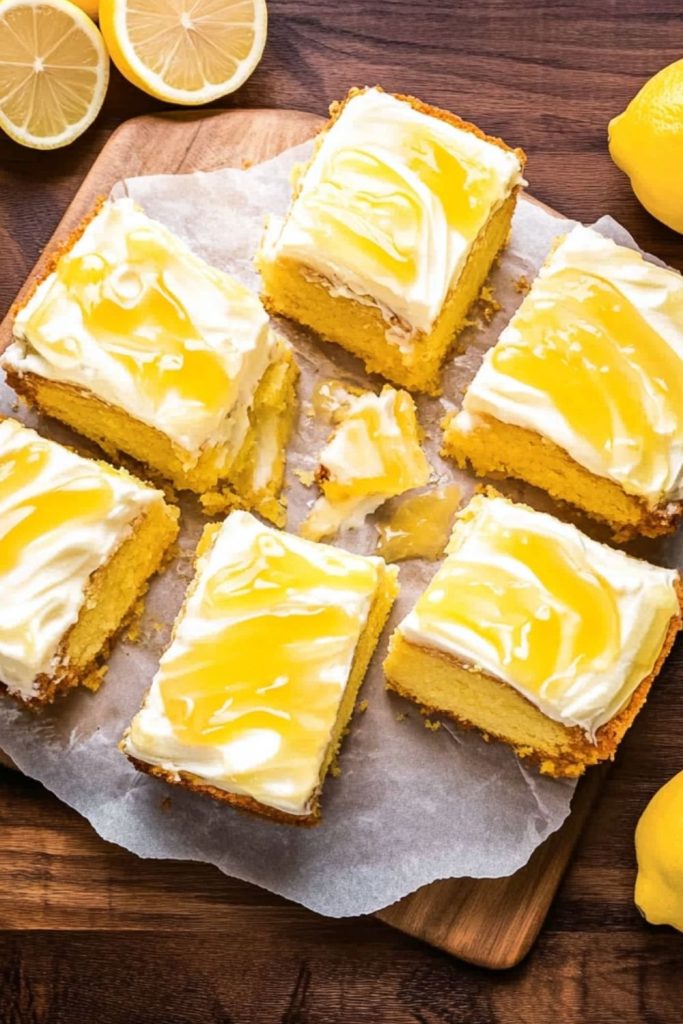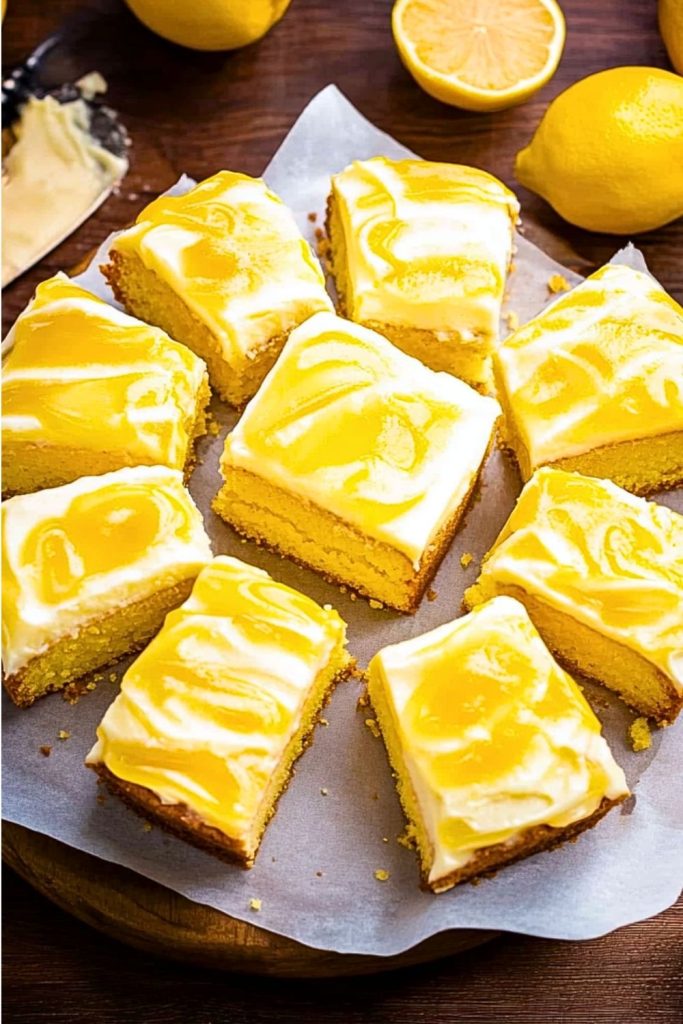There’s something deeply nostalgic about the scent of lemons baking in the oven. I remember the first time I made this Lemon Curd Cake — it was a gray Sunday afternoon that needed a bit of sunshine, and this cake delivered exactly that. Light, fluffy, and bursting with bright citrus flavor, it instantly became a staple in my kitchen. The sweet-tart lemon curd swirled into a tender vanilla cake, topped with a creamy frosting, creates the kind of dessert that gets requested again and again.

What I love most is how it straddles the line between comforting and refreshing. It’s the perfect treat for spring gatherings, baby showers, or simply to bring a little joy to the end of a busy week. Whether you make your lemon curd from scratch or use a favorite store-bought brand, this cake delivers a sunny zing in every bite.
Why You’ll Love This Lemon Curd Cake
- Bright citrus flavor: The lemon curd adds a punch of tanginess that cuts through the sweetness perfectly.
- Moist and tender texture: Thanks to the balance of butter and buttermilk, each bite is light yet rich.
- Beautiful presentation: With swirls of lemon curd and a creamy topping, it looks as stunning as it tastes.
- Versatile treat: Works as a show-stopping dessert or a simple afternoon snack.
- Crowd-pleaser: This cake tends to disappear fast at potlucks and family gatherings.
Questions and Substitutions for Lemon Curd Cake
What Kind of Lemon Curd Should I Use?
When it comes to lemon curd, you’ve got options. I personally love making my own — the freshness and intensity of flavor you get from homemade lemon curd is hard to beat. Plus, you can control the tartness and sweetness to suit your taste. But store-bought works beautifully too, especially if you’re short on time. Look for one with a thick, glossy texture and a deep golden hue — that’s usually a sign of rich, eggy curd with good lemon oil content.
If you’re going the homemade route, aim for a curd made with real lemon juice, zest, eggs (or yolks), butter, and sugar. If you’re buying, I recommend checking the ingredients list to make sure there are no unnecessary fillers or artificial flavorings. And if you want a twist, try a Meyer lemon curd — it has a sweeter, floral note that gives the cake an elegant flavor lift.
Options for Substitutions
Baking this cake is pretty forgiving, and you can get creative with ingredients without sacrificing taste or texture.
- Lemon Curd Substitute: Swap with lime curd, passionfruit curd, or even orange marmalade for a different citrus profile.
- Buttermilk: No buttermilk? No problem. Use regular milk with a tablespoon of lemon juice or white vinegar added — let it sit for 5 minutes to curdle.
- Flour: You can use a 1:1 gluten-free flour blend if needed. I’ve had good results with almond flour mixed in too, though it makes the cake denser.
- Butter: Use plant-based butter for a dairy-free version. Coconut oil also works but will slightly change the flavor.
- Frosting Alternatives: Cream cheese frosting is dreamy here, but mascarpone or even whipped coconut cream will also complement the lemon.
- Sugar: Granulated sugar is standard, but you can use a blend of white and brown sugar for added depth. Coconut sugar is a decent swap, though it will darken the cake.
Ingredients for This Lemon Curd Cake
Each ingredient in this Lemon Curd Cake plays a unique role in creating its soft, moist crumb and rich, citrusy flavor. Here’s why they’re essential:
- All-Purpose Flour – This forms the structure of the cake. It provides a sturdy but tender base that holds the moisture from the other ingredients.
- Granulated Sugar – Not only sweetens the cake but also helps to aerate the butter during the creaming process, making the texture light and fluffy.
- Unsalted Butter – Adds richness and a tender crumb. It also carries the lemon flavor beautifully and helps with that golden, delicious crust.
- Eggs – Crucial for binding the ingredients together. They add moisture and help the cake rise and hold its shape.
- Buttermilk – The acidity of buttermilk tenderizes the gluten in the flour, giving the cake a soft texture while enhancing the lemon flavor.
- Baking Powder & Baking Soda – These are your leavening agents, ensuring the cake rises well and stays fluffy.
- Salt – A pinch of salt brings balance, heightening the sweetness and intensifying the lemon.
- Lemon Zest & Lemon Juice – These bring the bold lemony brightness to the cake. Zest adds a concentrated citrus aroma, while juice sharpens the flavor.
- Lemon Curd – The star of the show. Swirled into the batter or layered in between, it adds that luscious, tangy punch that defines the entire dessert.
- Cream Cheese (for frosting) – Rich and tangy, it complements the lemon beautifully and creates a luxurious, spreadable topping.
- Powdered Sugar (for frosting) – Smooths out the cream cheese and provides that sweet contrast to the lemon’s tartness.
- Vanilla Extract – Just a touch warms up the flavor profile and rounds out the acidity from the lemon.

Step-by-Step Instructions for Lemon Curd Cake
Step 1: Preheat and Prep
Start by preheating your oven to 350°F (175°C). Grease and line a 9×13-inch baking pan with parchment paper, leaving an overhang on the sides for easy removal. This ensures the cake doesn’t stick and makes cleanup a breeze.
Step 2: Cream the Butter and Sugar
In a large mixing bowl, beat the unsalted butter and granulated sugar together until light and fluffy — about 3-5 minutes. This step is key for incorporating air and giving the cake a soft texture.
Step 3: Add Eggs and Vanilla
Beat in the eggs, one at a time, scraping down the sides as needed. Stir in the vanilla extract. This creates a rich and cohesive batter base.
Step 4: Mix Dry Ingredients Separately
In another bowl, whisk together the all-purpose flour, baking powder, baking soda, and salt. This helps the leavening agents distribute evenly throughout the cake.
Step 5: Combine Wet and Dry
Add the dry ingredients to the butter mixture in three additions, alternating with the buttermilk. Start and end with the flour. Mix just until combined — overmixing can lead to a dense cake.
Step 6: Add Lemon Zest and Juice
Fold in the lemon zest and lemon juice gently. These fresh citrus elements will infuse the batter with bright flavor.
Step 7: Layer the Lemon Curd
Pour half the batter into the prepared pan and dollop spoonfuls of lemon curd over the surface. Swirl gently with a knife. Repeat with the remaining batter and more curd, swirling again for a marbled effect.
Step 8: Bake
Bake for 30–35 minutes, or until a toothpick inserted in the center comes out clean or with a few moist crumbs. The cake should be golden and slightly springy to the touch.
Step 9: Cool and Frost
Let the cake cool completely in the pan before frosting. For the frosting, beat together cream cheese and powdered sugar until smooth and fluffy. Spread generously over the cooled cake, then swirl in a little extra lemon curd on top for that signature look.
Cooking Time and Pro Tips for Lemon Curd Cake
How Long to Cook the Lemon Curd Cake
The baking time for this Lemon Curd Cake is typically 30 to 35 minutes at 350°F (175°C). However, oven temperatures can vary, so it’s important to start checking for doneness around the 28-minute mark. You’re looking for:
- A golden top that’s slightly springy to the touch.
- A toothpick or cake tester inserted in the center should come out clean or with a few moist crumbs (not wet batter).
- If you’re using a glass or dark-colored pan, your cake may take a few extra minutes — keep an eye on it near the end.
Tips for Perfect Lemon Curd Cake
- Room Temperature Ingredients: Ensure your butter, eggs, and buttermilk are all at room temperature. This helps them blend more smoothly into the batter and improves texture.
- Don’t Overmix: Once you add the flour, mix only until everything is incorporated. Overmixing can toughen the cake.
- Use Fresh Lemons: Bottled juice can’t compete with the vibrant flavor of freshly squeezed lemon juice and fresh zest. It makes a big difference.
- Homemade Lemon Curd: If time allows, make your own. It will have a more intense, clean citrus flavor than most store-bought versions.
- Swirling Technique: Use a butter knife or a skewer to gently swirl the lemon curd into the batter. You want ribbons, not full integration.
- Chill Before Frosting: Let the cake cool completely — even chill it briefly if needed — before spreading the frosting. Warm cake can melt cream cheese frosting.
- Zest Smart: Only use the yellow part of the peel — the white pith underneath is bitter.
- Extra Curd on Top: A final drizzle or swirl of lemon curd over the frosting adds a beautiful, glossy finish and intensifies the lemon flavor.
Mistakes to Avoid and What to Serve with Lemon Curd Cake
Watch Out for These Mistakes While Cooking
Making Lemon Curd Cake is straightforward, but a few common pitfalls can get in the way of perfection:
- Using Cold Ingredients: Cold butter won’t cream properly, and cold eggs can cause the batter to curdle. Let everything come to room temp before starting.
- Overbaking: The difference between perfectly moist and slightly dry is just a few minutes. Keep an eye on the oven and check early.
- Not Measuring Flour Properly: Scooping straight from the bag can pack in too much. Instead, spoon the flour into your measuring cup and level it off.
- Skipping the Swirl: Pouring curd on top without swirling it in can cause it to pool and sink. Take the time to swirl it lightly for even distribution.
- Frosting a Warm Cake: Patience matters here — let the cake cool fully to avoid melting the frosting into a gooey mess.
- Too Much Lemon Juice: It’s tempting to add more juice for a stronger lemon hit, but too much can mess with the cake’s structure and make it soggy.
- Not Tasting the Lemon Curd: Whether store-bought or homemade, taste your curd before using it. Adjust sweetness if it’s too tart or acidic.
- Overmixing the Batter: Once the dry ingredients go in, mix just until blended to avoid a dense, tough cake.
What to Serve With Lemon Curd Cake?
This cake is delightfully bright on its own but pairs beautifully with a variety of sides for different moods and occasions.
1. Whipped Cream
A soft cloud of unsweetened or lightly sweetened whipped cream adds extra lightness and contrast to the tart lemon.
2. Fresh Berries
Raspberries, blueberries, or strawberries bring a burst of juicy freshness and a pop of color on the plate.
3. Vanilla Ice Cream
Especially when the cake is slightly warm, a scoop of vanilla ice cream makes it even more indulgent.
4. Hot Tea
Lemon Curd Cake pairs especially well with Earl Grey or chamomile — something floral or citrusy to echo the cake’s notes.
5. Sparkling Wine
Serve with a glass of Prosecco or a citrusy mimosa at brunch or celebratory events.
6. Lemonade
Keep the citrus theme going! Iced lemonade (or a lemon iced tea) adds a refreshing companion drink, perfect for summer parties.
7. Greek Yogurt
A small dollop of thick Greek yogurt adds a tangy contrast and turns the cake into a fancier breakfast or brunch option.
8. Pistachios or Almonds
Sprinkle some toasted nuts on top for crunch and added depth. Their subtle richness plays well with lemon.
Storage and Nutrition for Lemon Curd Cake
Storage Instructions
Whether you’re baking ahead for a gathering or saving leftovers (if there are any!), Lemon Curd Cake keeps beautifully with the right care:
- Room Temperature (Unfrosted): If you’ve baked the cake but haven’t frosted it yet, it can be stored in an airtight container at room temperature for up to 2 days.
- Refrigerator (Frosted or with Lemon Curd): Once frosted or if filled with lemon curd, store the cake in the refrigerator. Cover it tightly with plastic wrap or store in a cake container. It stays fresh for up to 5 days.
- Freezer: To freeze, wrap slices or the whole (unfrosted) cake tightly in plastic wrap, then foil. It can be frozen for up to 2 months. Thaw overnight in the fridge and bring to room temperature before serving.
- Make-Ahead Tips: You can make the lemon curd and frosting a few days in advance. Store both in airtight containers in the fridge and assemble the cake the day of serving.
Estimated Nutrition
Please note: Nutritional values are approximate and may vary based on specific brands and portion sizes.
For one slice (assuming the cake is cut into 12 servings):
- Calories: ~380 kcal
- Total Fat: 18g
- Saturated Fat: 10g
- Cholesterol: 95mg
- Sodium: 240mg
- Total Carbohydrates: 50g
- Sugars: 30g
- Protein: 5g
- Fiber: 1g
- Vitamin C: ~10% DV (thanks to the lemon juice and zest)
- Calcium: ~6% DV
- Iron: ~8% DV
This cake leans more toward indulgent than light, but the lemon makes it feel fresh and less heavy — a perfect balance.
Frequently Asked Questions & Conclusion
Frequently Asked Questions
1. Can I use store-bought lemon curd?
Absolutely. Store-bought lemon curd works wonderfully in this recipe. Just choose one with real ingredients and a thick, spreadable consistency. It’s a great time-saver and still gives you that bold citrus kick.
2. What if I don’t have buttermilk?
No buttermilk? No problem. Mix 1 cup of milk with 1 tablespoon of lemon juice or white vinegar and let it sit for 5 minutes. It’s a quick substitute that works just as well in the batter.
3. Can this cake be made gluten-free?
Yes! Use a 1:1 gluten-free flour blend that contains xanthan gum. The texture may be slightly different, but the flavor remains vibrant and delicious.
4. Do I have to use cream cheese frosting?
Not at all. While cream cheese frosting pairs beautifully with lemon, you can use whipped cream, mascarpone frosting, or even a lemon glaze for something lighter.
5. How do I know when the cake is done baking?
Check at the 30-minute mark. The top should be golden and a toothpick inserted into the center should come out clean or with a few moist crumbs — not wet batter.
6. Can I freeze Lemon Curd Cake?
Yes, and it freezes well. Freeze it without frosting for best results. Wrap slices tightly in plastic wrap and foil. Thaw overnight in the fridge and frost just before serving.
7. Is this recipe suitable for cupcakes?
Definitely! Divide the batter among cupcake liners and bake at 350°F for 18–22 minutes. Swirl a bit of lemon curd into each before baking.
8. Can I make this cake ahead of time?
Yes. Bake the cake a day or two ahead and store it tightly wrapped in the fridge. Add frosting and final lemon curd swirls the day you plan to serve.
Conclusion
Lemon Curd Cake is that perfect blend of tangy brightness and soft, buttery sweetness — the kind of cake that brings sunshine to your plate no matter the season. Whether you’re serving it at a spring brunch, a summer tea party, or just because you’re craving something citrusy and comforting, this cake never disappoints. The zesty curd, rich crumb, and creamy frosting all come together in a show-stopping dessert that’s both elegant and soul-satisfying.

Lemon Curd Cake Recipe
- Prep Time: 20 minutes
- Cook Time: 30 minutes
- Total Time: 50 minutes
- Yield: 12 slices
Description
Bright, tangy, and irresistibly soft, this Lemon Curd Cake is the citrus dessert you didn’t know you needed. With swirls of vibrant lemon curd folded into a moist vanilla cake and topped with a velvety cream cheese frosting, every bite is bursting with flavor and sunshine. Whether you’re looking for a quick breakfast idea, a crowd-pleasing dessert for dinner parties, or just a new easy recipe to liven up your snack table, this cake delivers. It’s one of those food ideas that’s both elegant and approachable — perfect for brunches, potlucks, or whenever you need a little pick-me-up. The zesty lemon flavor, rich texture, and creamy topping make it a go-to in your rotation of healthy snack alternatives or indulgent dinner ideas.
Ingredients
- 2 1/2 cups all-purpose flour
- 2 tsp baking powder
- 1/2 tsp baking soda
- 1/2 tsp salt
- 1 cup unsalted butter (room temperature)
- 1 3/4 cups granulated sugar
- 4 large eggs
- 1 tbsp lemon zest
- 1/4 cup lemon juice (freshly squeezed)
- 1 cup buttermilk
- 1 tsp vanilla extract
- 1 cup lemon curd (plus extra for swirling on top)
For the frosting:
- 8 oz cream cheese (softened)
- 1/2 cup unsalted butter (softened)
- 2 cups powdered sugar
- 1 tsp vanilla extract
Instructions
- Preheat oven to 350°F (175°C). Grease and line a 9×13-inch baking pan with parchment paper.
- In a medium bowl, whisk together flour, baking powder, baking soda, and salt.
- In a large bowl, cream butter and sugar until light and fluffy (3-5 minutes).
- Beat in eggs one at a time, then stir in vanilla extract.
- Mix in lemon zest and lemon juice.
- Alternately add flour mixture and buttermilk to the butter mixture, starting and ending with flour.
- Pour half the batter into the pan. Add half the lemon curd in spoonfuls and swirl gently with a knife.
- Add remaining batter and repeat the swirling with the rest of the curd.
- Bake for 30–35 minutes, until a toothpick comes out clean or with moist crumbs.
- Let cake cool completely.
- For the frosting, beat cream cheese and butter until smooth. Add powdered sugar and vanilla, and beat until fluffy.
- Spread frosting over cooled cake and swirl in extra lemon curd for garnish.

